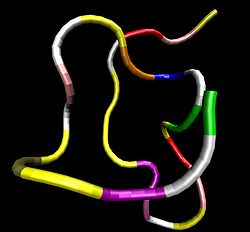
Atrial natriuretic peptide

1ANP, 1YK0, 3N574878230899ENSG00000175206ENSMUSG00000041616P01160P05125NM_006172NM_008725NP_006163NP_032751Atrial natriuretic peptide (ANP) or atrial natriuretic factor (ANF) is a natriuretic peptide hormone secreted from the cardiac atria. Natriuretic peptides (ANP, BNP, and CNP) are a family of hormone/paracrine factors that are structurally related. The main function of ANP is causing a reduction in expanded extracellular fluid (ECF) volume by increasing renal sodium excretion. ANP is synthesized and secreted by cardiac muscle cells in the walls of the atria in the heart. These cells contain volume receptors which respond to increased stretching of the atrial wall due to increased atrial blood volume.Body water: Intracellular fluid/Cytosol Atrial natriuretic peptide (ANP) or atrial natriuretic factor (ANF) is a natriuretic peptide hormone secreted from the cardiac atria. Natriuretic peptides (ANP, BNP, and CNP) are a family of hormone/paracrine factors that are structurally related. The main function of ANP is causing a reduction in expanded extracellular fluid (ECF) volume by increasing renal sodium excretion. ANP is synthesized and secreted by cardiac muscle cells in the walls of the atria in the heart. These cells contain volume receptors which respond to increased stretching of the atrial wall due to increased atrial blood volume. Reduction of blood volume by ANP can result in secondary effects such as reduction of extracellular fluid (ECF) volume (edema), improved cardiac ejection fraction with resultant improved organ perfusion, decreased blood pressure, and increased serum potassium. These effects may be blunted or negated by various counter-regulatory mechanisms operating concurrently on each of these secondary effects. Brain natriuretic peptide (BNP) – a misnomer; it is secreted by cardiac muscle cells in the heart ventricles – is similar to ANP in its effect. It acts via the same receptors as ANP does, but with 10-fold lower affinity than ANP. The biological half-life of BNP, however, is twice as long as that of ANP, and that of NT-proBNP is even longer, making these peptides better choices than ANP for diagnostic blood testing. The discovery of ANP was reported in 1981, when rat atrial extracts were found to contain a substance that increased salt and urine output in the kidney. Later, the substance was purified from heart tissue by several groups and named atrial natriuretic factor (ANF) or ANP. ANP is a 28-amino acid peptide with a 17-amino acid ring in the middle of the molecule. The ring is formed by a disulfide bond between two cysteine residues at positions 7 and 23. ANP is closely related to BNP (brain natriuretic peptide) and CNP (C-type natriuretic peptide), which all share a similar amino acid ring structure. ANP is one of a family of nine structurally similar natriuretic hormones: seven are atrial in origin. ANP is synthesized as an inactive preprohormone, encoded by the human NPPA gene located on the short arm of chromosome 1. The NPPA gene is expressed primarily in atrial myocytes and consists of two introns and three exons, with translation of this gene yielding a high molecular mass 151 amino acid polypeptide known as preproANP. The preprohormone is activated via post-translational modification that involves cleavage of the 25 amino acid signal sequence to produce proANP, a 126 amino acid peptide that is the major form of ANP stored in intracellular granules of the atria. Following stimulation of atrial cells, proANP is released and rapidly converted to the 28-amino-acid C-terminal mature ANP on the cell surface by the cardiac transmembrane serine protease corin.
